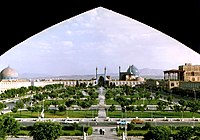
Photo from wikipedia
In the middle of May 2018, an unprecedented dust storm occurred in the Shiraz metropolis. After the storm, several samples were collected from dust that settled around the city. These… Click to show full abstract
In the middle of May 2018, an unprecedented dust storm occurred in the Shiraz metropolis. After the storm, several samples were collected from dust that settled around the city. These dust samples were analysed for potentially toxic elements (PTEs), rare earth elements (REEs), and radionuclides. This work is the first study that considered rare earth elements (REEs) for source identification and radionuclide contamination of Shiraz dust event. Hysplit model analysis and NASA and NOAA satellite maps illustrated that the air mass affecting Shiraz was moving mainly through the Saudi Arabian deserts. In addition, REE results of the dust that settled in Shiraz showed a trend similar to shale, sandstone, and especially Saudi Arabian soils. Ti/Al (0.01), Fe/Al (0.92), and Mg/Al (0.55) ratios and the values of LaN/SmN (0.91-0.98), GdN/YbN (1.8-2), LaN/YbN (1.7-1.9), HREE/LREE (0.52-0.6), Ce/Ce∗ (1.09-1.13), Eu/Eu∗ (1.03-1.18), Pr/Pr∗ (0.85-0.87), Gd/Gd∗ (1.1-1.15), and MREEs/MREE∗ (4.3-4.5) ratios provided insights into dust sources. These values indicated that Shiraz dust was affected by Asaluyeh and Iraq soils during transport and the main source of the dust that settled in Shiraz on the May 13, 2018 was Saudi Arabian soil. The concentrations of Mo, Cu, Pb, Zn, Ni, Co, Mn, As, Cd, Ti, Al, Sc, and Fe in the settled dust were 0.24, 47.67, 67.33, 244, 70.27, 19.33, 664, 8.39, 0.65, 537.33, 40933.33, 11.54, and 37800 mg/kg, respectively. According to the enrichment factor (EF), coefficient variation, and Positive Matrix Factorization (PMF) model the Mo, Cu, Pb, Zn, and Cd mainly originated from exhaust emissions and industrial activities. The activity concentrations of the radionuclides 7Be, 4 K, 137Cs, and 235U in the Shiraz-settled dust were 814, 421, 14, and 5.4 Bq kg-1, respectively and the activity concentration of 4 K was higher than the crustal average. Health risk assessment indices for the elements considering all three pathways revealed the following trend: dermal contact (HQderm)< inhalation (HQinh)< ingestion (HQing). The values of HQinh and HQing for children were higher than adults, while the values for the skin adsorption pathway for adults were higher than for children.
Journal Title: Chemosphere
Year Published: 2021
Link to full text (if available)
Share on Social Media: Sign Up to like & get
recommendations!